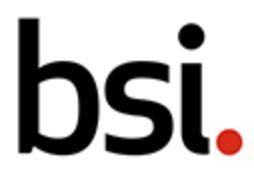Please be advised that a New Work Item Proposal has been loaded to the BSI Standards Development Portal for comment.
Any comments received will be submitted to the national committee AMT/4 “Industrial Data and manufacturing interfaces ” for consideration when deciding the UK response to the associated Standards Development Organisation.
Proposal: ISO/NP 23704-4 Reference Model for Cyber-Physically Controlled Smart Machine Tool Systems (CPSMT) — Part 4: Part 4: Requirements and guidelines for implementing reference architecture of CPSMT for subtractive manufacturing.
Please visit http://standardsdevelopment.bsigroup.com/projects/9023-08074
Comment period end date: 09/03/2023
Scope
This document specifies an implementation architecture (IA) of CPSMT for implementing functional architecture (FA) given in ISO 23704-2 including
– Implementation architecture for CPCM,
– Implementation architecture for CSSM and
– Interface architecture of CPSMT.
This document provides an implementation guideline (IG) of CPSMT including
– Information model of CPSMT for CPCM and CSSM, –
Communication model of CPSMT for CPCM and CSSM,
– Integration model of CPSMT and
– Digitalization model of CPSMT.
This document also includes use cases for CPCM, CSSM, UIS (Unified Interface System), SFDS (Shop Floor Device System), SFCS (Shop Floor Control System).
Purpose
Since Industry 4.0 and Smart Factory were announced/proposed by the German Government in 2011, worldwide attention has been focused on this topic. To cope with the megatrend, enabling technologies have been under development by Industry and R&D institutions. In the market there is a variety of so called ‘smart machine tools’ incorporating IoT, ICT, Services, based on individual concepts and using local terminologies by Machine Tool Builders (MTB), CNC vendors, Solution vendors, Business people (service providers), which is confusing for the stakeholders including end-users.
At present:
– From the market perspective, the abovementioned variety of solutions requires substantial modeling to establish smart machine tools for Industry 4.0.
– From the standards perspective, there are some standards on a high level, such as RAMI 4.0, SMRM, and related standards in parts under development by ISO/IEC.
– As far as CPSMT is concerned, the ISO 23704 series has been under development by ISO/TC 184/SC 1/WG 11 since 2018; including ISO 23704-1:Overview and fundamentals of CPSMT, ISO 23704-2: Reference architecture of CPSMT for subtractive manufacturing, ISO 23704-3: Reference architecture of CPSMT for additive manufacturing.
Drivers or necessities for ISO 23704-4 include:
– The reference architecture specified in ISO 23704-1, 2 is on a functional level and the question of how to implement the functional architecture into a physical realization of a CPSMT is a key issue raised by stakeholders including CNC and MTB venders.
– In other words, it is necessary to develop some sort of guideline for implementing reference architecture of CPSMT for the sake of physical realization of CPSMT in industry.
– Timing wise, now is appropriate as ISO 23704-1 and ISO 23704-2 have been published in June 2022, so that ISO 23704-4 can used as a guideline for stakeholders implementing CPSMT for Industry 4.0
– From the perspective of RAMI 4.0 (Reference Architecture for Industry 4.0), considering that ISO 23704-1, 2 are on the 5th level (function), while the physical level in the 1st level, in-between technologies, such as Information (4th level), Communication (3rd level), Integration and Digitalization (2nd level) need to be provided to realize the 5th to the 1st level.
Based on the necessities, the purpose/scope of the proposal is:
1) To specify Implementation Architecture (IA) of CPSMT for subtractive manufacturing,
2) To provide Implementation Guidelines (IG) for the Stakeholders of Smart Machine Tool Systems, including MTB, CNC venders, Solution vendors, Service Providers, and Users, etc., and
3) To provide information including fundamentals and Use cases, without crossing over the existing standards, but to be referenced from the perspective of Implementation of CPSMT for the stakeholders.
Expected users/beneficiaries include:
1) Design engineers in the area of smart machine tools for implementation for Industry 4.0
2) System architects in the area of smart machine tools for implementation for Industry 4.0
3) Software engineers at the machine tool builders in the area of smart machine tools for implementation for Industry 4.0
4) CNC vendors in the area of smart machine tools for implementation for Industry 4.0
5) Solution and service providers in the area of smart machine tools for implementation for Industry 4.0
6) End users like factory operators working with smart machine tools for Industry 4.0, etc.
Expected impact of this standard includes:
1) To promote clear and unambiguous communication between all interested parties of smart machine tools for implementation for Industry 4.0
2) To promote the interoperability of smart machine tools with related hardware devices, software, service, and manufacturing systems for implementation for Industry 4.0
3) To promote the quality/capability of smart machine tools for Industry 4.0
4) To promote systematic development, modification of smart machine tools for implementation for Industry 4.0
To promote use by e.g. factory operators, of smart machine tools for Industry 4.0.
If you have any comment or need more information, please contact Sami Ortiz at [email protected]

